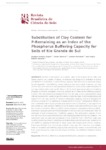Use este identificador para citar ou linkar para este item:
http://www.alice.cnptia.embrapa.br/alice/handle/doc/1056565Registro completo de metadados
| Campo DC | Valor | Idioma |
|---|---|---|
| dc.contributor.author | ROGERI, D. A. | pt_BR |
| dc.contributor.author | GIANELLO, C. | pt_BR |
| dc.contributor.author | BORTOLON, L. | pt_BR |
| dc.contributor.author | AMORIM, M. B. | pt_BR |
| dc.date.accessioned | 2016-11-17T11:11:11Z | pt_BR |
| dc.date.available | 2016-11-17T11:11:11Z | pt_BR |
| dc.date.created | 2016-11-17 | pt_BR |
| dc.date.issued | 2016 | pt_BR |
| dc.identifier.citation | Revista Brasileira de Ciência do Solo, Viçosa, MG, v. 40, 2016 | pt_BR |
| dc.identifier.uri | http://www.alice.cnptia.embrapa.br/alice/handle/doc/1056565 | pt_BR |
| dc.description | Mehlich-1 soil extract is currently used in Rio Grande do Sul (RS) and Santa Catarina (SC) States, in Brazil, to evaluate soil phosphorus available to plants and Mehlich-1 is sensitive to soil buffering capacity. This limitation is overcome partly by soil separation into buffering classes based on soil clay content. However, soil clay content has some technical and operational limitations, such as the underestimation of soil clay levels in soils under no-till. The aim of this study was to evaluate the remaining phosphorus (P-rem) compared to soil clay content as an index of the buffering capacity in soils of RS. The relationship between P-rem and soil clay content was assessed using 200 soil samples from a wide range of locations across the state. In 20 representative soil types, P-rem, soil clay content, P maximum adsorption capacity, total and pedogenic Fe contents, amount of P2O5 needed to increase soil P in 1 mg kg-1 extracted by Mehlich-1 and -3 methods and P capacity factor were determined. Furthermore, a pot experiment was carried out with plants to determine soil P content extracted by Mehlich-1 and -3 at the maximum technical efficiency (MET) and the maximum absorption efficiency (MEA). Correlation analyses were performed between P-rem and soil clay content and, with the attributes of soils involving the P buffering capacity. The relationship between P-rem and soil clay content was described as a decreasing exponential function; however, the adjustment was not adequate to propose critical levels for P-rem. The P-rem index was superior to soil clay index in practically all relationships with the attributes related to the soil buffering capacity of the soils. In some cases, the indexes were similar; however, P-rem was not lower than the soil clay content in any case. The P-rem is a more reliable index to represent soil buffering capacity than the soil clay content in soils from RS, and P-rem might be used to implement soil classes for Mehlich-1 and Mehlich-3 determinations of soil P. | pt_BR |
| dc.language.iso | eng | eng |
| dc.rights | openAccess | eng |
| dc.subject | Rio Grande do Sul | pt_BR |
| dc.title | Substitution of clay content for P-Remaining as an index of the phosphorus buffering capacity for soils of Rio Grande do Sul. | pt_BR |
| dc.type | Artigo de periódico | pt_BR |
| dc.date.updated | 2016-11-17T11:11:11Z | pt_BR |
| dc.subject.thesagro | Fertilizante fosfatado | pt_BR |
| dc.subject.thesagro | Solo | pt_BR |
| dc.subject.nalthesaurus | Phosphorus | pt_BR |
| dc.subject.nalthesaurus | Adsorption | pt_BR |
| riaa.ainfo.id | 1056565 | pt_BR |
| riaa.ainfo.lastupdate | 2016-11-17 | pt_BR |
| dc.contributor.institution | DOUGLAS ANTONIO ROGERI, INSTITUTO FEDERAL DE SANTA CATARINA; CLESIO GIANELLO, UNIVERSIDADE FEDERAL DO RIO GRANDE DO SUL; LEANDRO BORTOLON, CNPASA; MAGNO BATISTA AMORIM, UNIVERSIDADE FEDERAL DO RIO GRANDE DO SUL. | pt_BR |
| Aparece nas coleções: | Artigo em periódico indexado (CNPASA)  | |
Arquivos associados a este item:
| Arquivo | Descrição | Tamanho | Formato | |
|---|---|---|---|---|
| CNPASA2016rbcs.pdf | 396.56 kB | Adobe PDF |  Visualizar/Abrir |









